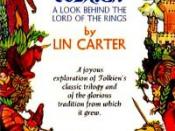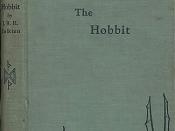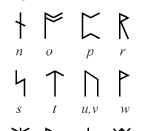The father of John Ronald Reuel (J.R.R.) Tolkien, Arthur Reuel Tolkien, was a bank clerk. He went to South Africa in the 1980's for better prospects of promotion. Along came his wife, Mabel.
John R.R. Tolkien was born in Bloemfontein, South Africa, on the 3rd of January, 1892.
He later said that one his clearest memories of living there, was a scary encounter with a large, hairy spider. This influenced his writing of Shelob the spider in his future classic "The Lord of the Rings".
In 1895, he, his mother and his young brother Hilary (born 1894), left South Africa to go back to England for a change of climate. His father decided to stay there, but died suddenly after they left, in 1896. They settled in the village of Sarehole, which greatly influenced The Shire, also in the Lord of the Rings, near Birmingham.
When Tolkien was 8 in 1900, the family converted to Catholicism.
In doing so, they angered many relatives. That same year, he was accepted into the prestigious King Edward VI School, but had to leave because of financial difficulties. However, in 1903, he won a scholarship and was able to re-enrol.
As a schoolboy, Tolkien found he had a love for languages. He made up his own language, "Animalic", and often spoke it with his two younger cousins.
On 15th October 1904, Tolkien's mother died from diabetes which was then incurable. Before her death, she entrusted the care of her boys to their priest Fr Francis Morgan.
When Tolkien was 16, he and his brother lived with a family who took in boarders. There he met Edith Mary Bratt and they became firm friends.
At school, he learnt Latin and Greek and was competent in other languages, both Modern and Ancient Gothic and Finnish.
In 1911, he went to Oxford University to study Anglo-Saxon, Gothic, Welsh and Finnish languages. While there, he made friends with C.S. Lewis. Due to disappointing marks in his Classics course, he decided to change to English Language and Literature.
War started in 1914. In 1915, Tolkien achieved a First Class degree. At that time, he was working on inventing some languages, especially one called Qenya, used by High Elves in some of his future books. This language was heavily influenced by Finnish.
Tolkien finally enlisted in the army as a lieutenant. Before going to war, he married his childhood sweetheart Edith Mary Bratt on 22nd March 1916. He was sent to active duty on the Western Front in time for the Somme offensive. After four months in the trenches, he became sick from a form of typhus-like infection, "trench fever". He was sent to hospital in Birmingham. He was better in a month and was able to spend Christmas with Edith in Staffordshire. All but one of his friends were killed in action.
At this time, he started writing stories as an outlet for his feelings. Among them, were the tales of the lovers Beren and Luthien. These stories were the early forms of his later book, The Silmarillion.
On 16th November 1917, his first son John Francis Reuel (later Fr John Tolkien), was born.
After the war, Tolkien became a professor at Oxford University. Coincidentally, he again met C.S. Lewis who had also become a professor there.
Three more children came, Michael Hilary Reuel (October 1920), Christopher Reuel (1924) and later Priscilla. Tolkien continued with his made-up languages and published books including Mr Bliss and Roverandom - which he had told his children as bedtime stories.
In 1928, Tolkien was grading some test-papers. He later recalled, "One of the candidates had mercifully left one of the pages with no writing on it (which is the best thing that can happen to an examiner) and I wrote on it: 'In a hole in the ground, there lived a hobbit'". So Tolkien set out to find what a hobbit was and what kind of hole it lived in. The book The Hobbit was based wholly on that sentence. It was first published on the advice of Raynor Unwin, the 10-year-old son of the owner of George Allen and Unwin Publishing Firm in 1937.
Tolkien was asked for another 'Hobbit story' so he started compiling his earlier stories into the Silmarillion, and submitted that. It was refused because the publisher said it was "not commercially publishable". Next, he started what was to be The Lord of the Rings, which turned out to be a sequel to The Hobbit. He estimated that it took 14 years to write. He finished his final draft in 1949. By the time it was published by George Allen and Unwin, he had reached his 60th birthday. The book was too big to publish at once, so it was split into three parts: The Fellowship of the Ring, The Two Towers and The Return of the King. It was later re-published with index and appendices. Later, the Silmarillion was reworked and published.
Tolkien retired from his post as professor in 1969 and moved with his wife to Bournemouth. On 22nd November 1971, his wife Edith Mary Tolkien died.
In 1973, Tolkien was awarded the Order of the British Empire from Queen Elizabeth II. This is one rank lower than a knighthood, which he would probably have received if he had lived longer and not died later that same year, on 2nd September.
Edith Mary and John Ronald Reuel Tolkien were buried together in the Catholic section of Wolvercote Cemetery in the northern suburbs of Oxford. Their headstone reads:
Edith Mary Tolkien, Luthien, 1889 - 1971
John Ronald Reuel Tolkien, Beren, 1892 - 1973.
"I am in fact a hobbit in all but size. I like gardens, trees, unmechanized farmlands, I smoke a pipe and like good, plain food - unrefrigerated - but I detest French cooking. I like, and even dare to wear in these dull days - ornamental waistcoats. I'm fond of mushrooms out of a field, have a very simple sense of humour (which even my most appreciative critics find tiresome). I go to bed late and get up late, whenever possible."
- J.R.R. Tolkien


